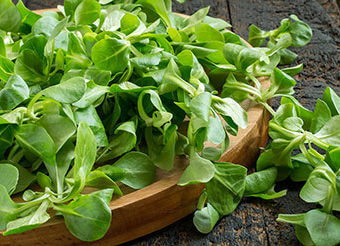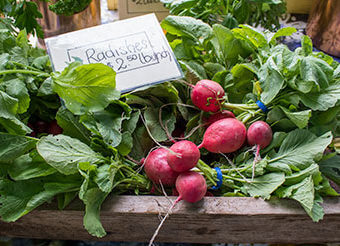The first average frost date for Lower Mainland BC is November 2. This date is reflected pretty closely from the Sunshine Coast and Gulf Islands, coastal Vancouver Island, Puget Sound, and down to the Willamette Valley in Oregon. That means we have approximately eleven weeks of growing time before we can reasonably expect the cold to impact unprotected crops.
If you live outside this region, simply use a search engine with the phrase "first frost date" and the name of your (nearest) town.
With even minimal crop protection, we can extend the season even further, but this time of year is critical for planting fall and winter harvest vegetables, and for getting some cover crops started to improve the soil over winter. Here’s our list of seeds to sow mid-August:

Arugula loves cool soil and cold weather. Keep an eye on the weather forecasts, and sow arugula seeds once nighttime temperatures are dipping down to 15°C (60°F) or lower. Don’t plant all the seeds at once, though. It’s a better plan to sow another short row every two weeks until around the third week in September. I don’t have a favourite arugula, but Astro Organic stays nice and mild, and makes an excellent micro-green as well.

Corn Salad enjoys the same planting conditions as arugula, but it is far more cold hardy, so it can be harvested well into winter. A lot of North American growers are still unfamiliar with this crop, but it is a beautiful, tasty, succulent vegetable for use in salads. I’ve never heard from anyone who tried it and did not like it. It’s great for containers and small beds because corn salad plants do not get large. There are a couple of named varieties, but I think Europeans generally just grow Mache or Vit.

Carrots will take full advantage of the 75+ days left in the season, but they must be planted in the next two weeks to take advantage of fall harvests. Remember to keep the carrot seed bed well wet until germination — this can be tricky when day time highs are above 25°C (77°F). The top layer of soil tends to dry out very quickly if it is not covered or lying beneath a drip line. Use a tarp or a piece of lumber to cover the soil in order to minimize evaporation. Read more on How to Grow Carrots. There are many excellent carrots for fall and winter harvest, but I was blown away by Yellowstone Organic as a roasting vegetable. It has the best flavour and texture, but it wants to be cooked. Harvest some for Thanksgiving, or even Christmas dinner.

Endive, like corn salad, remains unfamiliar to many North American gardeners despite its easy growing, wide range of flavours and leaf types, and overall deliciousness. Endive, and its cousin Radicchio, are most often described as being “bitter,” which does a terrible disservice to these amazing vegetables. Bitter is not a bad thing, but it is different than “sweet.” I enjoy savoury dishes, so I find endive and radicchio extremely useful. They are great for breaking up the routine of lettuce-based salads… Try my Simple Radicchio Salad recipe and tell me it’s not sublime. Anyway, to take advantage of these remarkable and diverse salad greens, the seeds have to be planted right away. I love radicchio, but for a fall endive crop, I recommend Italian Dandelion… Toss freshly picked in with some cooked (hot) bacon with a bit of the fat, and then add some sultana raisins for contrast. Serve warm and you will know the truth about endive!

Kale will, of course, grow well into winter from a mid-August planting. If you’re not bored with kale after a summer-long supply, please consider planting some for winter. It is the ultimate winter workhorse, and so easy to grow.

Lettuce can still be planted and grown to full maturity before frost comes. And try some of the cold-hardy types like Winter Density and Rouge d’Hiver for harvesting after frost. I recommend planting a couple of the early maturing loose-leaf types this week, and then adding some cool-loving romaines in two weeks’ time. If you have the luxury of a greenhouse, just think of lettuce as your standby easy vegetable for all winter production.

Mesclun mixes can go into containers now, or into short rows in the garden. Because these are harvested at immature size after only four weeks or so, they can be planted multiple times. Sowing more seeds every two weeks will supply a couple or small family with ample salad greens throughout the fall. You can’t go wrong with our tried and true West Coast Market Mix.

The Mustard family includes a very diverse range of salad greens, from frilly Mizuna to the substantial Giant Red. Mustard seeds, by their nature, do not require warm soil to germinate, and the plants thrive in cool weather. Plant mustard when you plant arugula and corn salad (mentioned above), and use the abundant leaves to liven up fall and winter salads. Komatsuna remains one of my favourite winter vegetables. I love it raw or cooked. It’s fast and easy to grow and totally trouble free.

Pac choi loves cold weather as well. Its growth slows down as autumn approaches, so the plants are easier to harvest at their peak, before bolting, as they tend to do in early summer. If you’re still unfamiliar with using pac choi in soups and stir-fries, or pickling, sautéeing, or eating raw in salads, it’s time to learn. This is a very easy group of vegetables to grow in containers or right in the garden bed. They are fast growing and nutritious, and available in a range of sizes and flavours. Mei Qing Choi is a hybrid with incredible uniformity, mild flavour, and perfect shape. Try harvesting some immature rosettes and stir-fry them whole.

Radishes want cool soil. They mature incredibly fast from fall plantings, so do short rows every couple of weeks. The exotic looking watermelon radish will only produce its root ball if it’s grown in cold soil. It is a winter vegetable only. That particular variety may do best from an October planting.

Spinach seeds for late summer? Oh yes! Try planting some spinach rows during the third week in August. These will produce a bountiful fall harvest, but don’t pull the plants up. Harvest as needed into quite frosty weather, but leave the roots intact. Next spring, you’ll get a vigorous, enormous harvest of spinach earlier in the season than you would expect, and long before any pest insects are present. I have a soft spot for the French heirloom Monstrueux de Viroflay. The spring time leaves can be huge and floppy, but stay tender and delicious.

Cover Crop seeds can go into any space not being used for vegetable production. The best ones for this time of year are barley, buckwheat, and oats. These can all be tilled under before frost comes, and your soil will thank you for it. Both barley and oats can be left to die off when the cold weather hits, and they will form a mulch, holding soil in place and reducing weed pressure. They will add abundant carbon to the soil for spring planting.
One last note – please make sure all your orders are in if you want to get some of our Seed Garlic for Fall Planting. Music Organic garlic is my personal favourite for its unbeatable cold hardiness and extra large cloves. This ships across Canada in September.



